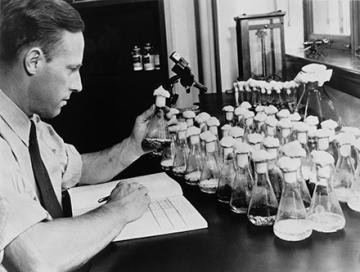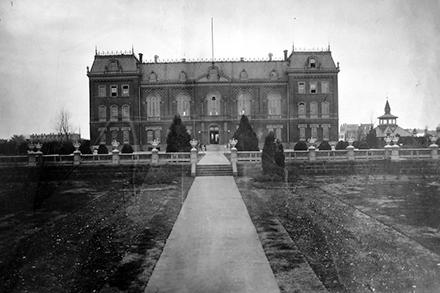The Agricultural Research Service: A History of Innovation
This year marks the Agricultural Research Service's (ARS) 70th anniversary, making it a particularly appropriate time to look back at the founding of this revolutionary agency and its scientific accomplishments.
To fully appreciate the importance of ARS, we have to rewind to 1862, long before ARS was established. In 1862, the United States Department of Agriculture (USDA) was founded, and the history of U.S. federal agricultural research began.
On May 15, 1862, during the American civil war, President Abraham Lincoln signed a bill establishing USDA – what he called "the People's Department". This bill was followed by the Morrill Land Grant College Act, granting each state 30,000 acres of land for the construction of "agricultural and mechanical schools" leading to the creation of land-grant colleges.
USDA grew out of the United States Patent Office’s Agricultural Division, which had been established in 1839 with the mission to acquire, propagate, evaluate, and distribute seeds and plants, and to collect agricultural statistics and production information.
On July 1, 1862, Isaac Newton, then chief of the Agricultural Division, was appointed by President Lincoln as the new Department's first commissioner. In the beginning, Newton headed a staff of 38 employees in the basement of the U.S. Patent Office. However, by 1889, the USDA occupied its own building with over 400 employees and had achieved cabinet status.
The passing of the Hatch Act in 1887 (and the establishment of the Office of Experiment Stations in 1888) provided $15,000 annually for the establishment of one or more agricultural experiment stations in each state with the purpose of conducting agricultural research and "dispersing useful and practical information connected with agriculture." Dr. Wilbur O. Atwater was the first director of the Federal Office of Experiment Stations — these stations became essential to agricultural research and development.
Early USDA research wasn't solely in the agricultural realm. Scientists also worked diligently on human nutrition research.
In May 1894, Atwater became USDA's first chief of nutrition and went on to oversee more than 300 food studies in 17 states. He was widely regarded as the father of modern nutrition research and education. To this day, calorie values for foods are calculated using the Atwater system — each gram of protein is said to contain 4 calories, each gram of fat 9 calories, and each gram of carbohydrates 4 calories.
In the beginning, much of early research in USDA was conducted by scientists in state labs that later became part of the new scientific agency. Much of that research continues to benefit farmers, ranchers, and the public today with the USDA screwworm eradication program being one particularly noteworthy example.
For years, screwworms (parasitic flies) were a devastating pest of the U.S. Southwest, Florida, and parts of Georgia. The larvae of the screwworm eat living tissue of people and other animals.
In 1937, USDA screwworm research was initiated in the Bureau of Entomology and Plant Quarantine at a USDA laboratory in Texas. USDA scientist Edward F. Knipling came up with the idea of flooding affected areas with sterilized male screwworm flies. The theory being the large numbers of released sterile male flies would mate with nonsterile female screwworm flies, resulting in a decrease of the population and over time driving the flies to extinction. In what is considered one of the greatest entomological success stories of all times, screwworms were eventually eradicated from the U.S., Mexico, and Central America by the 1980s.
Equally important research relates to the "Dust Bowl" of the 1930s. In the wake of a multiyear period of severe dust storms stretching across several states, the USDA Soil Conservation Service and the Texas Agricultural Experiment Station created a lab in Bushland, Texas. Years of poor agricultural practices and severe drought left the soil of extensive U.S. farmland exposed to severe wind erosion and resulting dust storms. The Bushland lab, working with experiment stations and other labs, began investigating methods to minimize the potential for another Dust Bowl. The results of their research were the forerunner of the highly successful practice of no-till and other forms of conservation tillage used today.

Andrew Moyer, in his Peoria laboratory, discovered the process for mass producing penicillin.
Perhaps one of USDA's greatest scientific achievements occurred in the 1940s during World War II. Penicillin, a mold with bacteria-killing powers, was discovered in 1928 by Scottish microbiologist Alexander Fleming. However, it was not until 1941, in the midst of WWII, that a team of scientists from the University of Oxford in England and scientists at what was then the USDA Northern Regional Research Laboratory in Illinois devised methods of growing the mold using deep-tank fermentation and producing penicillin yields that surpassed anything achieved before. Drug companies then used these methods just in time to produce enough penicillin to treat Allied soldiers wounded on D-Day in 1944.
On November 2, 1953, a Secretary's Memorandum redesignated the Agricultural Research Administration—established in 1942—as the Agricultural Research Service. This established ARS as USDA's chief scientific research agency with the job of "conducting research to develop & transfer solutions to agricultural problems of high national priority".
Over the years, many familiar products have resulted from ARS research, such as frozen foods, sunflower seed butter, Roma tomatoes, improved frozen orange juice concentrate, fire-resistant cotton and Pampers and lactose-free milk. Today, 2,000 ARS scientists at 90+ research locations are conducting impactful, revolutionary research in all areas of agriculture, with more than 600 research projects occurring at any given time. ARS has earned a worldwide reputation as a scientific organization delivering scientific solutions to national and global agricultural challenges.
To learn more, visit our new Research Timeline to read about the many agricultural research accomplishments ARS scientists have achieved from 1862 to the present. — By Nancy Vanatta, ARS Office of Communications.


